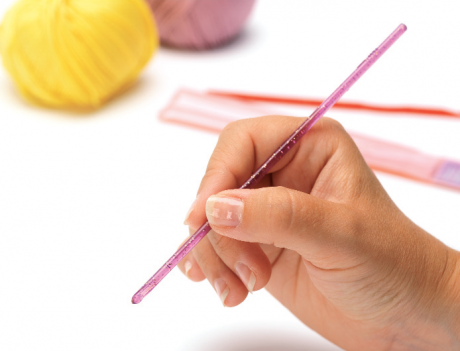Whether crochet has always seemed like a slightly scary stranger or you’ve just never tried, take a look at our step-by-step guide
Fallen in love with some cute crochet projects, but don’t know one end of a hook from the other? Think that dc is a reference to the American capital? Or maybe trying crochet after years of knitting just feels like a step too far? Well, help is on hand. We’ve put together a ‘how to’ guide of all you need to know to get started. With easy-to-follow handshots and clear instructions, it covers the basics of holding the hook and yarn, making a foundation chain and working a slip stitch, plus the secret of how to produce row after row of neat double crochet – before long you’ll be totally hooked!
Common abbreviations:
ch = chain
dc = double crochet
sl st = slip stitch
Holding the hook
There are two common methods of holding a crochet hook. Both are correct, but the most important thing is to find one that’s most comfortable for you. Try both to see which you prefer.
1. Like a pencil

2. Like a knife

Holding the yarn
Tensioning the yarn is key to achieving smooth and even stitches but can take time to get the hang of. Wrap the working yarn around your little finger, weave it underneath the next two fingers and use your index finger to hold it taut. Grip the work with your third finger and thumb.

Foundation chain
The foundation chain is the basis of most crochet projects
1. Make a slip knot and put it on the hook – do not pull too tight. Coming from behind, wrap the yarn around the hook.

2. Catch the yarn and use the hook to pull it through the slip knot. You have now made one chain (ch). Continue to make more chains as directed in the pattern.
NOTE: the slip knot does not count as a chain.

Slip stitch (sl st)
A slip stitch is used to create an invisible stitch, and also for joining the round if you are working in a ring
1. Insert the hook into the second chain from the hook (or as directed in the pattern), there will now be two loops on the hook.

2. Wrap the yarn around the hook and pull the yarn through both loops.
NOTE: the loop on the hook does not count as a chain.

Double crochet (dc)
This is the main crochet stitch. It is also known as plain crochet and is called single crochet in the US, so always check the country of the pattern you are working with.
1. Repeat Step 1 for slip stitch. Wrap and pull the yarn through the nearest loop on the hook. You will have two loops on the hook. Wrap the yarn around the hook.

2. Pull the yarn through both loops on the hook. You have now completed a dc. Continue along the row, working a dc into each ch in the foundation row.
NOTE: after the first row, you will have one less stitch than in your foundation chain.

For the second row, make one ch (known as the turning chain) before working into first ch in row. Unless instructed otherwise, insert the hook under both loops that create the v-shape.

Tips from the top
LK designer Helen Jordan is an expert on all things crochet and the founder of web store Thread of Life. She shares her knowledge and advice on getting to grips with the craft.

- Relax! Learning is meant to be fun; enjoy it. Take your time and don’t demand perfection straight away. Practice for a short time only and make a date to do so every day (or more often!) Try doing some of the basic stitches into open light card with holes punched into it, or open-weave fabric.
- Keep a light hold of the yarn to help you keep even tension. The hook part of the hook head loves the shoulder of your yarn-holding arm so keep it facing that way as much as possible. Move your grip up/along very few stitches and work in the space between the forefinger and middle finger of the yarn-holding hand.
- Use firmly spun and plied smooth yarn that has some elasticity for your samples. Cotton is an inelastic fibre and cruelly displays every variation in tension. Avoid textured yarns until you have mastered the technique as some fancy yarns are challenging to use.
- Make sure you wrap the yarn round the hook the way that is shown in the diagrams, or your stitches will look different and some techniques will be difficult to work.
- Know where any patterns come from - UK and USA patterns use the same terms but for different stitches.
Thread of Life sells a wide selection of hard-to-find crochet hooks, notions, patterns, yarns and cottons. Helen also runs workshops and classes. Call 07702 392935 or check out www.threadoflife.co.uk





_333_180_64_c1.jpg)



_333_180_c1.png)
_333_180_c1.png)
 Baby
Baby
 Toys
Toys
 Garments
Garments
 Crochet
Crochet
 Homewares
Homewares
 Dolls
Dolls



Share